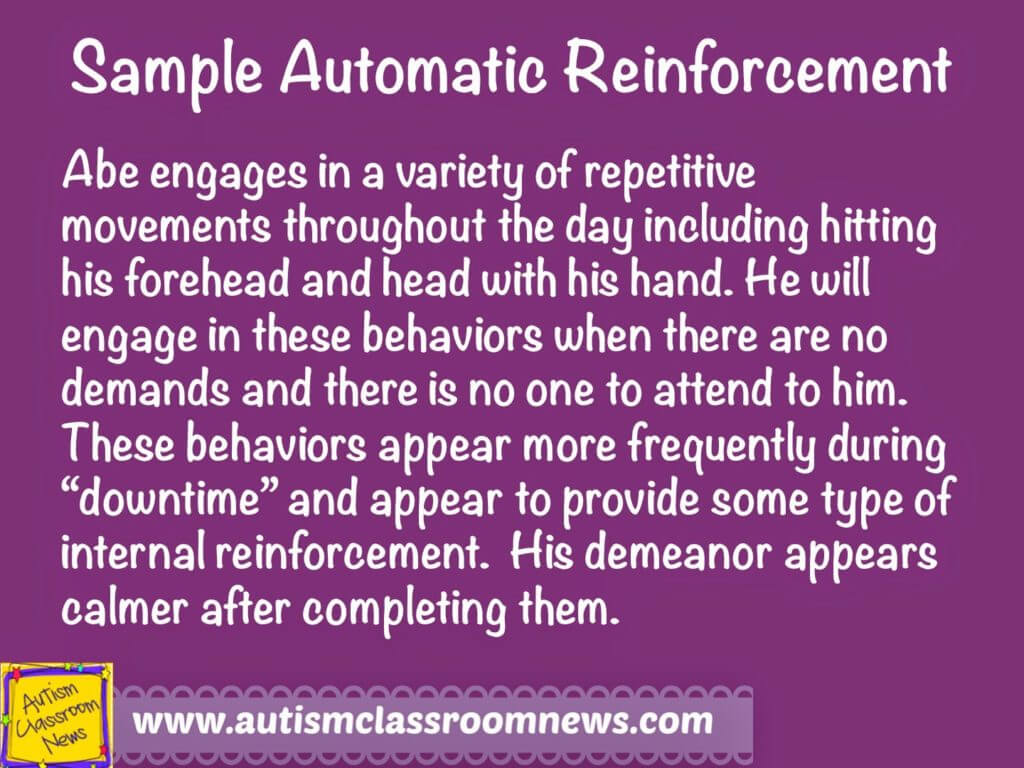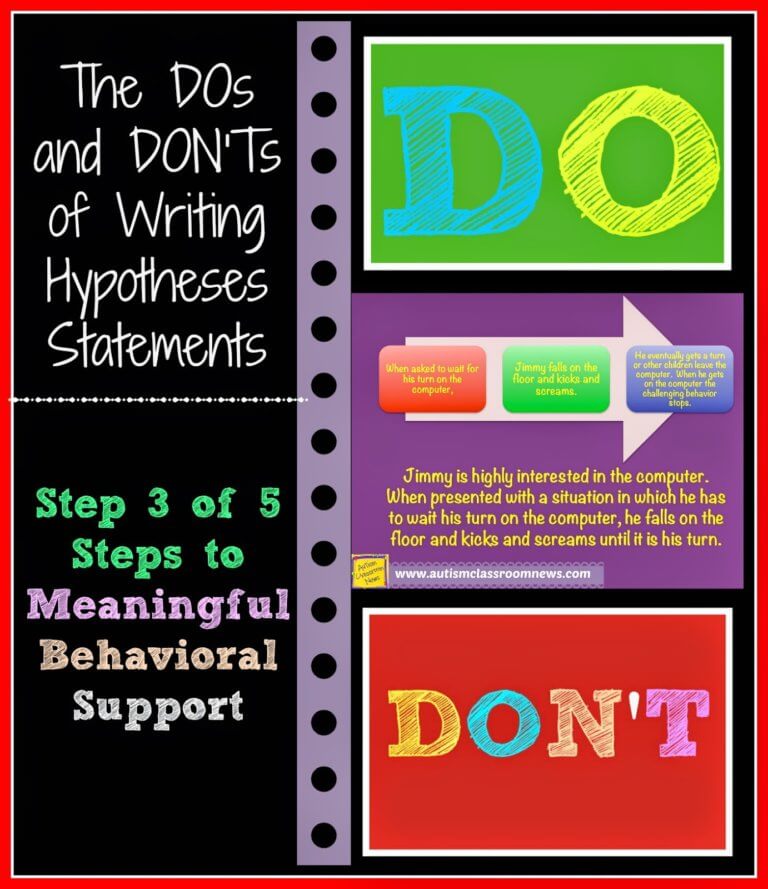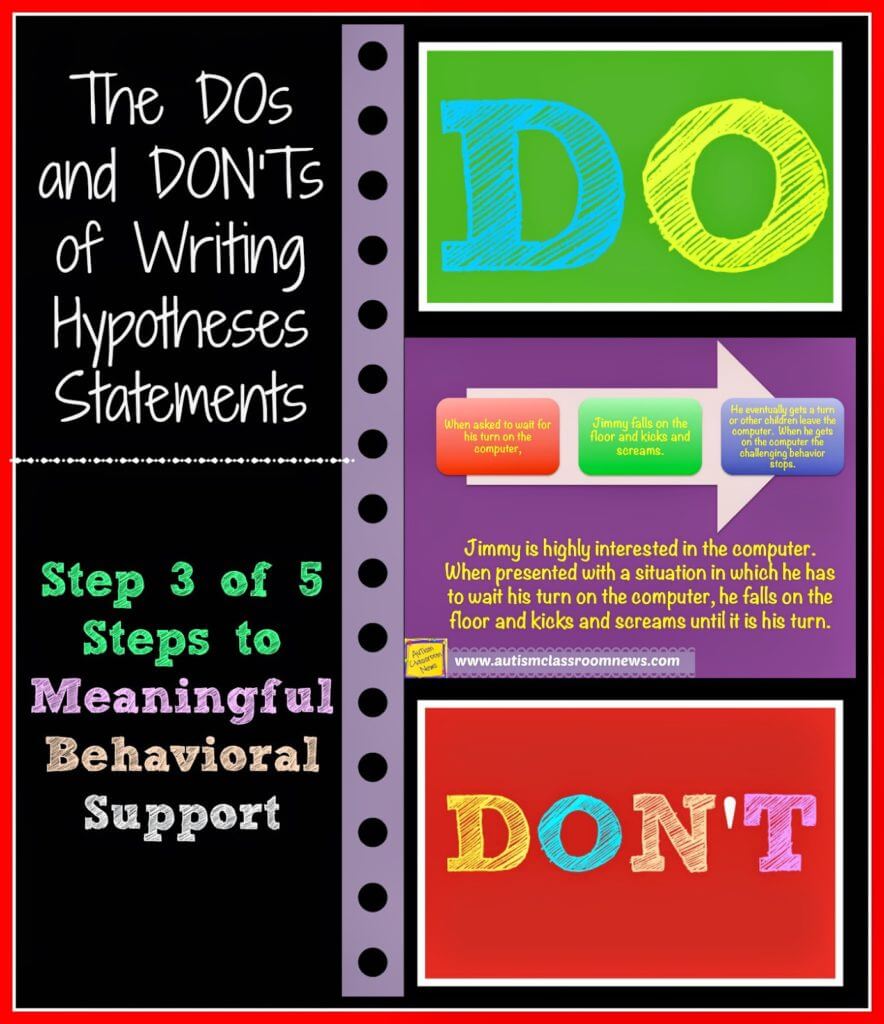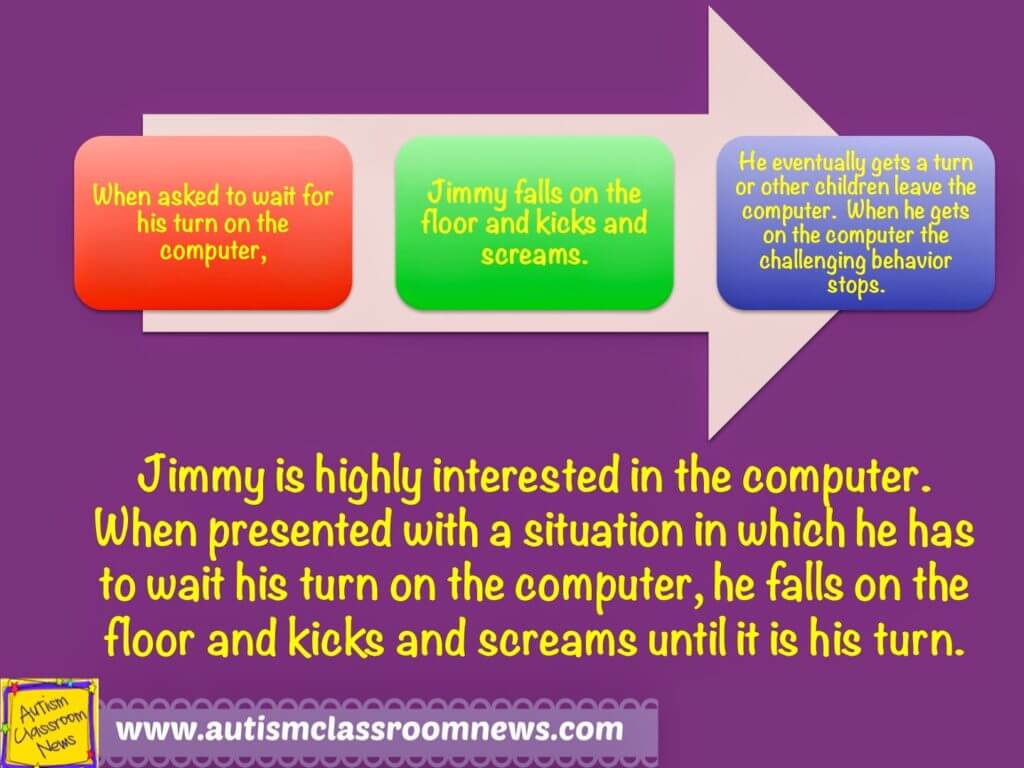To see the other posts in this series click HERE.
So I’m back at promised with some helpful tips for writing hypothesis statements that lead to successful behavioral support. This will finish up step 3 (developing hypotheses) and we will be ready to move on to what we all were waiting for–creating behavioral support plans. I know that the process of an FBA can seem ridiculously long, especially when you are dealing with some really difficult behavioral issues. However, I can tell you that without this process, the behavioral support will not be as successful and the process will just get longer. Being able to develop strong hypothesis statements that are our best guess about why the behavior is occurring is like a doctor doing a throat culture to see if your sore throat is strep. If it is, antibiotics will help. If it isn’t, they won’t and you have to address it a different way. Just giving you antibiotics doesn’t eliminate your sore throat and it has side effects of making you (and the population) more resistant to that treatment (antibiotics) in the future. So, with all of that said, here are some things to know about writing hypothesis statements that will hopefully help lead to better behavioral support. It’s a bit long so grab your favorite beverage and dive in. Or click on the pictures and the Pin button to pin it for later. 🙂
1. DO: Include as much information in the hypothesis as possible
If you use the template from my last post, you will end up with a statement that includes common antecedents and consequences to the behavior with a conclusion about the overall function of the behavior. The more details you include, the better able you will be to develop a plan that addresses the whole problem. Clearly Jimmy’s behavior is motivated by gaining access to a tangible activity (tangible function). However, knowing that his behavior has a tangible function just tells us that he needs to learn to make a request for what he wants. It doesn’t tell us what he should be taught to make a request for.
Knowing that he has this difficulty with computer time tells us that he needs to be able to request a turn on the computer, specifically. In addition, knowing it’s a tangible function doesn’t tell us what we could do to structure the situation and prevent problems before they occur WHILE Jimmy is learning to request a turn on the computer. We all know that our students don’t learn skills overnight and behavior is like a habit. You don’t just replace it overnight. So there will be a time where those antecedent-based interventions are important to restoring order in your world. Knowing more about the antecedents in the hypotheses statements let’s us know that we might want to have a clear signal about when the computer is or is not available, perhaps not have Jimmy have free time turns with other students where he has to give up his turn while he is learning to ask and wait, and perhaps that we need to have some visual supports at the computer to facilitate turn taking.
Similarly knowing the consequence tells us that we want to structure the situation so that someone is available to facilitate the computer area to keep other students from giving up and giving him access to the computer following his tantrum (thereby reinforcing the negative behavior). So, the more details we have, the more our behavioral support is laid out for us.
2. DO: Only describe what you can observe
This one is really hard in some ways, particularly if you are talking about behaviors that have an automatic reinforcement function (i.e., something internally is reinforcing the behavior like his anxiety decreases when he bites his hand or he stays awake / alert through self-injurious behavior during downtime. Many students have difficulties with sensory regulation and with anxiety and depression and sometimes their behavior is related to internal thoughts of negativity or the need to reduce that anxiety. I’m not discounting that emotions play a role. However, I am saying that we can’t know what those emotions are so they can’t play into our description of them. In Simon’s case he can report that he doesn’t like those social situation in which he makes violent threats. My data tells me that he gets kicked out of those situations because of his threats and the types of situations in which he makes them are almost always group social situations. I also know that Simon has significant deficits in social skills that leads to my conclusions. Saying that Simon is angry because he is in the social situations doesn’t tell me what to do; I don’t know how to keep Simon from being angry. However, I can teach him social skills that will help him be more successful and I can provide more support in those situations to help him be more comfortable.

In Abe’s case, he can’t report that, so I have to interpret it. I don’t know if Abe is engaging in self-injurious behavior because of some biological mechanism that is releasing endorphins that make him feel better. However, I do know that his behavior occurs almost entirely when he is left alone with nothing to do and that he does appear calmer after engaging in the behavior (i.e., he isn’t bouncing his leg, he isn’t making vocal sounds as frequently, he isn’t pacing across the room). By sticking to what I can see and/or what has been reported, we are more likely to be accurate in what we are reporting and again, we can make changes that will lead to better support. In Abe’s case we may want to structure his day so there is less downtime and perhaps use some antecedent exercise as a way to help with sensory regulation, among other supports.
3. DO: Include setting events
Setting events are an important part of knowing what we need to accommodate for. We may not be able to change them (for instance, I can’t cure a child with allergies) but we can accommodate for them. Then we can teach the student, when he is able, to advocate for and accommodate on his own. Remember that setting events are things that happen in the more distant past that make challenging behaviors more likely to occur when an antecedent presents itself. So, for instance, if Sarah doesn’t sleep well at night, she is more likely to cry when you ask her to come to morning meeting. To accommodate the setting event (since I can’t make her sleep better) I might let her have a break to chill out before morning meeting, let her take a short nap when she arrives in class, or make morning meeting start with her favorite activity to make it more enticing. Or might let her ask for a break to get out of the activity on those days. Knowing a setting event is involved is really helpful in planning behavioral support.
4. DO: Verify the hypothesis
A hypothesis is only a guess about the function of behavior. There are several ways we can verify the accuracy of that guess, but the most functional way is to create a behavioral support plan that addresses the hypothetical functions and take data to see if it works. Another way is to conduct an analogue functional analysis, in which we systematically manipulate the consequences for behavior in controlled conditions and determine how the behavior reacts. For instance, if the behavior increases over time it when I remove work after the behavior, then the function is likely to escape from work. This is a somewhat technical method for assessing behavior and not something that is often done in schools except by someone with specific experience and training (since it involves reinforcing the behavior initially). I’ve chosen not to talk about it much here because it’s not something you can really learn effectively through a blog post–it requires hands-on training among other things. Another way is called a structural analysis in which we change the antecedents to see if specific events we think might be triggers for the behavior reliably produce the behavior when presented. This requires careful data collection and shouldn’t be attempted without training because it involves setting the student’s behavior off. However, it is an easier approach for verifying than an analogue functional analysis and there are some researchers who have advocated that it might be more useful in schools. If anyone wants more information about either of these approaches, leave me comments and I’ll be happy to do future posts on either or both. For our purposes in this series, I would say your intervention serves as your “verify” step. If the intervention doesn’t work, we go back to questioning whether our hypotheses are correct.
1. DON’T: Be mislead by the form of behavior
Be careful not to assume that because the form of the behavior is sensory-based (e.g., putting hand in mouth, biting his hand) that the function is. Many, many, many behaviors may begin with a sensory function but quickly acquire a more “social” function of getting attention or escaping from situations. There is some literature to support that a certain percentage of babies bang their heads on their cribs. Sometimes this is due to ear infections and sometimes it’s not. Regardless of the original cause, banging their heads gets parents’ attention. If children don’t develop more sophisticated methods of gaining attention (or those methods don’t work) that headbanging can gain a social function of gaining attention. Over time it likely escalates in severity because lower levels of the behavior stop working to gain attention. Similarly a young child may mouth his hand as he mouths all the objects around him (a typical developmental phase). If that behavior causes people to remove him from a situation, then the behavior may take on an escape function over time. Just because the form of the behavior involves the senses, doesn’t mean it has a sensory or automatic reinforcement component.
2. DON’T: Assume automatic reinforcement if you can’t determine a function
Some people will tell you that if you can’t find a pattern to the behavior data, then the behavior probably has an automatic or sensory function. That is one of the biggest mistakes I see with functional assessments. Your assumption if you can’t find a pattern in the data should be that you don’t have enough data and you can’t determine the function. Just because you can’t see a pattern doesn’t mean one doesn’t exist and doesn’t mean that the reinforcement is something you can’t see because it’s internal. Only
3. DON’T: Assume there is only one function to the behavior
Human behavior is a pretty complex thing and it’s unlikely that we will explain someone’s challenging behavior with only one hypothesis / function. Most behavior is multi-functional. The older the student gets and the more experience he/she has with challenging behavior, the more likely the challenging behavior may come to serve more than one function.
4. DON’T: Stop taking data
Since we still need to verify the validity of the hypotheses statements, we are still going to need data to tell whether our intervention was effective. Our ABC data can provide baseline data for this, if we took it throughout the day or in controlled conditions, but we will need data to compare it to. I’ll spend more time talking about data within behavior plans later in the series, but it continues to be important. Sometimes just having a plan of what to do makes us feel like the behavior is better when in fact it has stayed the same. Data is the only way to monitor its true effectiveness and thereby verify if our hypotheses were correct.
So that brings us to the end of the FBA process of behavioral support. Our next step will be figuring out what to do based on our hypotheses of the functions of the challenging behaviors. I will pick up there later this week, but I have a special surprise coming up on Wednesday.
It’s become increasingly evident from responses on my Facebook page that everyone LOVES ideas for workbaskets. I’m going to start a monthly linky on Wednesday called Workbasket Wednesday. Any blogger can link up a post about workbaskets and structured work systems to Wednesday’s post and put the graphic from the post in their post and link back to the linky post. If you are not a blogger, feel free to share pictures with me (through Facebook or message me through my Facebook page) and I’ll be happy to publish them. Or share links to pins on Pinterest in the comments of Wednesday’s post. I will publish this post for link-ups the last first Wednesday of every month so we will have a monthly opportunity to share workbox ideas. So bloggers get your posts ready and I’ll have it up and running on Wednesday for your to link up.
Until next time,












